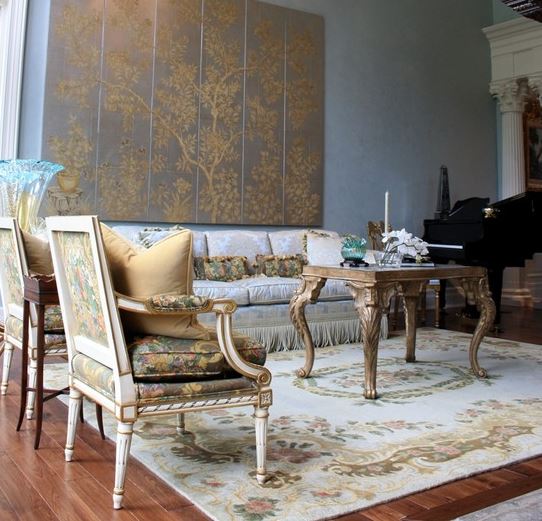Antique Aubusson rugs
Antique Aubusson rugs made in tapestry technique are among the most elegant and luxurious antique floor coverings. The fact that Aubusson rugs were easier to manufacture is the leading reason why so many rugs from this manufacturer were ordered by the aristocracy for their castles and chateaux enabling them to custom make rugs for unusually large spaces in a fraction of the time it would take to weave in pile. Aubusson rugs’ history is rich and a significant part of the revival of the arts of the Renaissance period. They were hand woven flat weave wool rugs and tapestries originally based on Turkish designs. In 1665 and thereafter, Aubusson rug designs were based on the motifs of Savonnerie rugs.
Aubusson is a town on the Creuse River in central France. It has been famed for its Rugs as well as Tapestries since the 15th century. Aubusson Rugs made in tapestry technique are among the most elegant and luxurious antique floor coverings. The history of Aubusson rugs dates back to the Renaissance period in the town of Aubusson located on the banks of the River Creuse in the Creuse valley of central France about 200 miles from Paris. The first looms were likely set up in Aubusson in the 1300s by Flemish refugees, but tapestry and rug production did not begin there until the 16th century. Aubusson rugs are French style hand woven flat weave rugs. Among hundreds of types of rugs used for floor coverings, aubusson rugs are very unique with distinguishing character of soft French decor. Elegant floral and architectural elements can be easily found in an aubusson rug and many aubusson rugs have a medallion in the centre with flowers and florals surrounded. With rich color combinations, aubusson rugs can match various decors and refresh your room instantly providing a comfortable, elegant and harmonious French atmosphere.
Aubusson is well known for its tapestry and Rugs, which have been famous throughout the world since the 14th century. Its origins were born with the arrival of weavers from Flanders, who took refuge in Aubusson around 1580. There is a famous collection of Aubusson tapestries at Vallon-Pont-d’Arc. The style of the tapestries produced has changed through the centuries, from scenes of green landscapes through to hunting scenes. In the 17th Century, the Aubusson and Felletin workshops were given “Royal Appointment” status. A downturn in fortunes came after the French revolution and the arrival of wallpaper. However, tapestry made something of a comeback during the 1930s, with artists such as Cocteau, Dufy, Dali, Braque, Calder and Picasso being invited to Aubusson to express themselves through the medium of wool. Aubusson tapestry still thrives today, preserving a range of traditional skills. In 1983, l’Atelier Raymond Picaud chose Burhan Doğançay’s Ribbon Series as a tapestry subjects.Coventry cathedral’s famous Christ in Glory tapestry, designed by artist Graham Sutherland, was woven in nearby Felletin. Installed in 1962, this was the world’s largest vertical tapestry up until the 1990s.
Source:
http://www.alifafarug.com/






